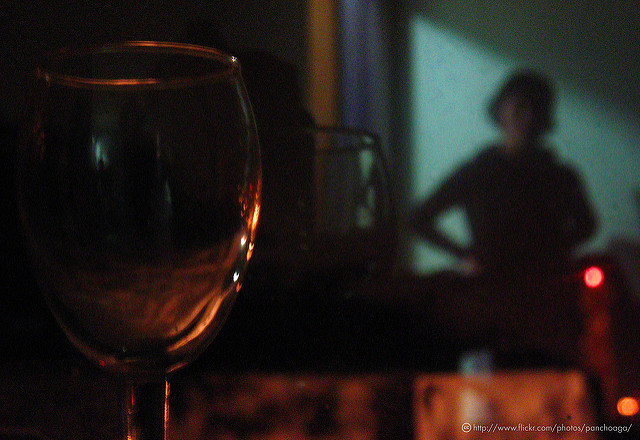On Women and Wine

Image via Jorge Panchoaga on Flickr / CC BY 2.0
Note: The gendered aspects of wine are constructed within the conventional gender binary, therefore this article will focus on issues that concern a binary understanding of masculinity and femininity.
Subtle rosés, crisp whites, and full-bodied reds wait in sleek bottles for the tired mainstream media stereotypes: a twenty-something who picks them off the shelves for her next girls’ night, the rom-com queen in pajamas who sips them from a long-stem glass while she cries about men, and the middle-aged housewife who pours them three, four, five times as she discusses “The Handmaid’s Tale” at her monthly book club.
Wine as we know it embodies the construct of the feminine, traded in our cultural circles as the sensual, lighter counterpart to masculinized beer. A 2012 Gallup poll showed 52 percent of women prefer wine to other alcoholic beverages, versus only 23 percent of men. The percentages of men and women who choose beer are almost exactly reversed.
Companies often market their wine as a woman’s best friend: wine brands such as Mommy’s Time Out and Mad Housewife offer wine as a respite from motherhood, Girl’s Night Out Wines promises the ideal beverage for “laughing about that hilarious cat video,” and “The Bachelor” wants you to enjoy their exclusive line of wines while watching their show. These marketing angles establish wine as a staple in any modern “female ritual.”
On the other hand, when men drink wine in mainstream culture, it’s often as an elite connoisseur in Napa who puzzles over notes of cocoa and tobacco, or as a business executive who channels wine’s persona as the seductress in the courtship dance for a new client. Meanwhile, for women, the feminine qualities attributed to wine are entrenched in a misogynistic image of womanhood comprised of fragility, sex appeal, and a preference for the social over the intellectual.
Mascha Davis, MPH, RDN, a Los Angeles dietician nutritionist, says wine’s construction as feminine might come from the female body’s tendency to metabolize alcohol more slowly than men’s bodies.
Most wines check in at around 12 percent alcohol content, in contrast to hard liquor’s usual 40 percent. Beer, however, rarely exceeds 10 percent, making the supposedly innate delay in the female body’s breakdown of alcohol an insufficient explanation for wine’s characterization as “female.”
Wine’s much-advertised health benefits and lower caloric content compared to beer or liquor might also feed into its stereotypical feminine quality, Davis says. Women are socialized to fear gaining weight, which could contribute to an affinity for wine’s healthier persona and an aversion to the prospect of a “beer belly.” In fact, the female-targeted company Chick Beer’s primary selling point is its low calorie and carb content. The cultural conventions surrounding beer, including burping and watching sports, also serve to distance beer from typically “ladylike” behaviors.
It is also possible that wine’s portrayal as a complex, mysterious beverage might engage the trope of the woman as “elusive” or “difficult to understand.” “Sexual appeal” is another feminine adjective people tend to apply to wine.
Classist notions of femininity figure into the depiction of wine as well. Elite, expensive restaurants often feature wine cellars and serve patrons bottle upon bottle — wine is commonly understood as a “classy” drink. Wine is thus marketed to a particularly privileged concept of womanhood and those who can afford to embody it, tying it closely with the image of the middle- or upper-class housewife.
In her book “Maybe Baby,” journalist Laurie Abraham detailed the implicit gender bias in viewing wine as an aid for stressed mothers.
“There’s a cultural taboo against inebriated mothers,” Abraham wrote. “As for inebriated fathers, that’s just what fathers do.”
Wine’s lighter alcohol content compared to hard liquor makes it less threatening to the middle class ideal of the nurturing, stable mother. The danger here is that wine becomes a relatively acceptable crutch for dealing with the numerous demands society places on women, evading the importance of addressing women’s mental health and normalizing potential indications of substance abuse.
Amanda Greenbaum, third-year sociology student and co-founder of The Sommelier’s Club at UCLA, lived on a Malibu vineyard as a teenager. Her club draws equal interest from men and women, and she has never noticed a gender disparity in the way the men and women in her family relate to wine.
“Once people immerse themselves in the culture of wine and learn about how it’s an intellectual process more so than just a casual drinking process, the [feminine] stereotype goes away,” Greenbaum said.
The prospect of eliminating gender stereotypes surrounding wine by educating people about the beverage may hold promise, but simply assimilating women into the elitist, masculine renditions of drinking wine is an insufficient solution. The gendered concept of wine and beer will only be deconstructed once issues of hegemonic gender roles are faced straight on, with the intent to make alcohol gender-neutral.
Gendered marketing tactics for food and beverages must be abandoned, since the arbitrary gendering of alcoholic drinks serves no one (but perhaps niche capitalist interests). Wine, like food, appeals to individual palates and not some ill-defined gender category.
The subtle rosés, crisp whites, and full-bodied reds await our cultural reconstruction.




